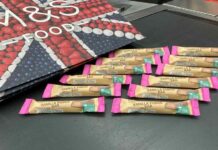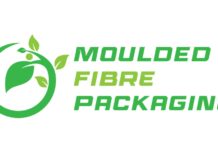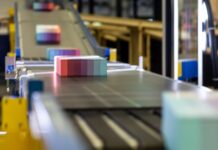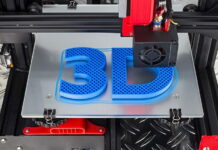Active and intelligent packaging (A&IP) is being increasingly utilised by brands to achieve various results. From brand protection to brand promotion and many advantages throughout the supply chain, smart/connected packaging is delivering very real benefits, far from novelty technology for the sake of it.
“It’s fair to say there’s an increasing demand for connected packs in most sectors,” says Dan Bowyer, design and innovation director at strategic innovation and design agency Drink Works. “Connected packaging has been around for many years and in many guises, from the consumer focused augmented reality which allows the brand to support their storytelling by bringing the packaging to life, through to manufacturer orientated connected technology that allows the brand to track and trace their product during production and distribution.
“What we’re also seeing is a corresponding focus on quality over quantity as consumers show aversion to gimmicky tech over something that adds value.”
Many brands would probably share that aversion, not wanting to spend money on something, beyond the primary functions of packaging, if consumers might only get a mildly diverting gimmick at best. Cameron Worth, chief executive and founder at connected experience specialist Sharp End, clearly feels smart packaging has much more to offer particularly when the correct strategy is applied.
“The interest in connected packaging is definitely on the rise as marketers wise up to the compelling fact that brand engagement can be achieved when packaging technology is properly married with the right creative thinking within the right strategic framework,” says Worth. “Obviously that rise is more prevalent in some sectors than others, but the tipping point really is coming from the realisation that technical expertise is only effective when it’s partnered with the right services/experiences delivered to end-users.”
According to 360 Market Updates, the active and intelligent packaging market was valued at $17.48bn (£13.78bn) in 2017, and it is expected to reach a value of $28bn (£22.08bn) by 2023 which highlights its rapid upward trajectory. Previously some packaging specifiers might have thought the cost of smart packaging was a stumbling block but several A&IP technology specialists have announced developments that bring the costs right down.
PragmatIC, a specialist in ultra-low cost flexible electronics, says its ConnectIC family will be pivotal in the acceleration of the smart packaging market. Developed using PragmatIC’s platform of patented technologies, ConnectICs deliver connectivity solutions at low cost. The FlexICs are ultra-thin and flexible; suitable for embedding into a wide range of substrates, including paper and plastic; and reduce the complexity of inlays by using single layer antennas, delivering a further step down in cost to brand owners and retailers. The company recently announced a strategic partnership with Mühlbauer, technology supplier of RFID and smart label production and personalisation systems, to deliver solutions that support the integration of PragmatIC’s FlexICs.
“Generally, our solution helps reduce tag and solution cost considerably, up to 80%,” says Scott White, PragmatIC’s chief executive. “The Mühlbauer partnership is focused on two key objectives: ensuring our FlexICs can be handled using the existing installed base of RFID assembly equipment, eliminating any barriers to adoption; and optimising the assembly process to take full advantage of the thin and flexible nature of our FlexICs to further reduce cost in the future.”
Sustainability now integral
As sustainability has become integral to packaging, it’s not surprising to learn that A&IP technology specialists are not limiting their foresight to advancements in digitisation but are looking to align it with environmentally-friendly solutions. Using his company’s tech as an example, White points to reasons why sustainable and smart/connected packaging are not mutually exclusive.
“Firstly, PragmatIC FlexICs take significantly less resources to produce,” adds White. “Secondly, they are made from environmentally benign materials and comprise a tiny proportion of the smart packaging (for example, less than 0.1% by weight of an RFID tag) so have no adverse impact on standard recycling processes. Thirdly, FlexICs allow the rest of the solution to be much more environmentally friendly. For example, they make it much easier to construct RFID/NFC tags with paper substrates and printed antennas, rather than conventional plastic substrates with chemically etched antennas.
“And finally, the use of FlexICs to track individual items and packaging with a unique digital identity allows better management of waste, and the benefit of waste reduction far outweighs the small amount of additional material used.”
Christine C. Akselsen, chief executive of Kezzler, whose patented serialisation technology is used to combat counterfeiting, track and trace and consumer engagement, agrees that smart packaging is not a hindrance to environmentally-friendly packaging and can actually benefit sustainability efforts.
“When it comes to serialisation, the product is made digital through the application of a unique, secure and traceable code that can be embedded into a QR, alphanumeric, or any other code. As such it does not present a challenge for recyclable packaging,” says Akselsen.
“In fact the code is an opportunity to support sustainability efforts, for example by providing consumers with additional information as to how and where they can recycle their products beyond what can be displayed on the packaging. In our experience serialisation can also positively contribute to waste reduction efforts. Ensuring supply chain visibility means brands can check where their product is at any time, helping them to optimise distribution to reduce inventory shrinkage and waste.”
While it seems like there’s been a, largely consumer-driven, stampede towards sustainability in packaging of late, the issue of compatibility between digitised packaging and sustainability is not a new one. Bowyer acknowledges that there was a time when it was sustainability versus smart. At best that would have meant striking some kind of balance.
“Sustainability has been the debate of the decade for our sector, with a key tussle between prioritising smart or sustainable. As smart pack tech evolves though, we’re seeing the two work symbiotically to complement each other. A case in point is the Deposit Return Scheme (DRS) that operates in about a dozen countries. Consumers pay a small fee at POS which is then refunded when they return a bottle or can and scan its barcode at a DRS machine. This simple combination of smart and sustainable packaging has resulted in more than 90% of plastic bottles being recycled in Germany, Norway and Sweden.
“What’s exciting is that the potential of what could be a compelling combination isn’t limited to scannable codes and recycling schemes. Going forward, smart packaging can improve existing recycling infrastructure by using tracking software to offer more transparency to a plastic bottle’s journey. For example, if you find a plastic bottle on the beach in the Maldives today, then it is impossible to find out the bottles journey and how it ended up in the sea. Yet with trackable technology, you’ll be able to scan the bottle, see its journey and identify and rectify the leak in the recycling system.
“This is just one of a number of future opportunities that smart packaging affords and it’ll be interesting to see how new technologies will be used to boost sustainability efforts. What’s without doubt is the fact that smart packs are here to stay and you’ll see increasing numbers of them on shelves near you, soon.”
And of course there isn’t just one type of technology in use and the eco-friendliness of packs might depend on the type of electronics embedded. “There are two dominant smart packaging technologies that brands are embracing: those which are produced via printing techniques (which are by their nature comparatively sustainable, such as QR Codes); and those that use NFC tags,” explains Worth.
“NFC tags have a reputation for being less environmentally friendly, yet if you look at the strides being made in this field, there are already several moves being taken to make NFC tags fit for the circular economy. Manufacturers are developing more environmentally friendly alternatives, such as creating NFC tags that are silicon free.
“There are also other measures, like using smart packaging to drive positive behavioural change, where connected packaging can play a pivotal role in helping consumers to dispose of products correctly.”
One example of A&IP giving consumers such information and guidance is Sharp End’s collaboration with the Horizon 2020 consortium targeting UK recycling for which it designed and built a digital product that incentivised recycling through gamification.
Also tackling waste through smart pack technology is CupClub, a returnable packaging service for drinks that uses RFID technology and cloud-based IoT software to provide supply chain traceability, helping retailers reduce single-use plastic packaging through trackable products and an in-built loyalty scheme.
“All of our cups, lids and drop cases are RFID tracked which means we can see a client’s daily usage trends and translate this into optimised inventory levels of cups in addition to providing clients with bespoke dashboards containing information on their environmental savings to date made by switching to CupClub,” said the company’s head of sales Dan Anderson. The firm is currently developing CupClub Pro. This involves using data to track cup movements and will essentially tag a cup to a consumer (who is a member the club) at the point of purchase, using a deposit return system to ensure re-use of the cups.
There’s certainly a solid connection forming between A&IP and sustainability which will surely chime with the tech savvy, eco-conscious generation.




























